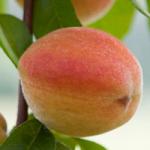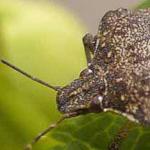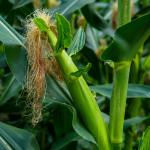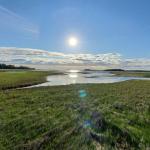In Our Spotlight
UMass Experts Offer Advice
“The climate of the Northeast is changing. Temperatures of the region increased by almost 2 degrees F since 1895 and precipitation increased by 5 inches (more than 10% per decade). Growing seasons lengthened by more than a week. These gradual changes are punctuated by more hot days, fewer cold days, and more intense rain.”
So begins a 2015 comprehensive assessment conducted by the Northeast Climate Hub of USDA (based at UNH) and the Northern Forests Climate Hub of USDA. This assessment documents climate change vulnerability along with ways to adapt to and mitigate problems. In 2020, gardening has become one of the signature hobbies of the Covid-19 pandemic. This year, many more residents have “saving the gardens” at the top of their minds.
With water damage, soil erosion, increased insects and invasive plants in our gardens and forecasts of even more changes on the horizon, we turned to experts in the fields of agriculture and climate change at the University of Massachusetts Amherst who work for or are associated with the Center for Agriculture, Food and the Environment. Climate change has become a common denominator and important facet of all their work.
What follows is a snapshot of current thinking and practical steps you can take to grow your own vegetables and fruit successfully. For more detailed information on specific matters, we invite you to check out resources at ag.umass.edu and from the extensive list of links to resources at the end of the story.
 Remember The Year With No Peaches?
Remember The Year With No Peaches?
Jon Clements, tree fruit specialist in UMass Extension, is a serious weather geek. Years of research and experience make him uniquely qualified to share ways in which specific weather events affect fruit growers. Here’s what we heard from him.
Although we are still in a sweet spot to grow most tree fruits, weather, insects, and diseases are always a challenge and action must be taken to prevent crop loss or damage. This includes choosing the best sites, the best varieties, and using pesticide sprays to keep out the unwanted bugs and pathogens. Being a perennial crop, tree fruits are subject to weather extremes throughout the year.
Assuming climate change will result in greater temperature extremes (highs and lows) and rain amount (floods and droughts), those weather extremes affect how one might grow pome (apple and pear) and stone (peach, plum, cherry) fruits at home as well as in commercial orchards, in the following ways.
Siting fruit trees -- Years are gradually getting warmer overall with earlier springs. Although it seems counterintuitive, the risk of spring frost increases. Most fruit trees are very susceptible to crop failure when trees bloom very early in the spring and then sub-freezing temperatures occur. This has been more of a problem farther south, but it is likely to be more of a problem in the northeast as the climate warms. My advice is to plant fruit trees only on the best sites with some elevation so cold air can drain to lower elevations. This is why most commercial orchards are on hills. An example of temperature extremes occurred on February 14, 2014 when a relatively warm week of winter temperatures was followed by a plummet to -10 degrees F., killing all the peach flower buds resulting in no peach crop during that summer. It was dubbed the "Valentine's Day massacre" by peach growers.
Drought and flooding -- one seems to follow the other. Fruit trees need an adequate supply of water, so a source of water is important during times of drought. On the other hand, fruit trees are not tolerant of flooded soils, so pick sites with good drainage so trees are not subject to extended periods of “wet feet.”
Apples and pears will still be within the range where they can be grown quite nicely, but some apples, like our traditional McIntosh, don’t really like hot summers that much, so fruit quality and color can suffer. Whereas Gala apples actually like warmer weather, so variety selection will become more important. Sunburn of the fruit surface is becoming more of an issue on all varieties. Stone fruits generally like hotter and drier weather, and warmer winter temperatures, but be wary of temperature swings during the winter which can result in loss of cold hardiness and then tree injury or crop loss when the temperature rapidly falls below zero following a period of warm winter temperatures.
Pests and diseases -- we are seeing increasing incidence of invasive pests from farther south, as well as increased disease incidence with wetter weather. Choosing disease-resistant varieties or netting backyard trees to keep insects out may be necessary with climate change.
You might think it easier to just go buy those fruits from a local orchard, and you’d probably be right! Good luck.
Honey Bees, Pollination and Climate Change
 Hannah Whitehead, honey bee extension educator in the UMass Department of Biology, works with Massachusetts beekeepers to provide educational resources about hive management and honey bee health. She had quite a bit to say.
Hannah Whitehead, honey bee extension educator in the UMass Department of Biology, works with Massachusetts beekeepers to provide educational resources about hive management and honey bee health. She had quite a bit to say.
Nearly half of all crops in Massachusetts rely on pollination by honey bees, bumble bees or solitary native bees in order to produce fruit. It is important to distinguish between honey bees – domesticated social insects brought to the US from Europe in the 17th century – and native bees. There are over 400 wild bee species in New England alone.
Actions you can take to support bee health:
- The most important thing you can do is to plant native flowering plants that bloom throughout the growing season. This provides a diverse diet for native pollinators or honey bees that visit your garden. More information on pollinator planting.
- Mow your lawn less. A few years ago, researchers from UMass published a study showing that mowing yards every 2-3 weeks had more flowers and supported more bees than if they were mowed every week, greatly increasing pollinator habitat. Another benefit is that mowing less cuts back on emissions that contribute to climate change as it decreases gasoline use. More information on the Research Buzz.
- If you are a beekeeper, buy local bees and practice Varroa IPM. More information for beekeepers and More information on Varroa IPM.
Crop pollination and beekeeping have changed dramatically over the last 25-50 years, because of several interacting trends: - Native bee habitat and floral resources have declined precipitously due to urbanization and changes in agricultural policy (larger monocultures, more herbicides, fewer hedgerows, fewer flowering cover crops, etc.). In the past, most farmers relied on native bees for crop pollination; now, because of declines in native bee populations, many need to rent honey bees to pollinate their crops. Fewer flowers means worse nutritional resources - and moving bees around the country for pollination can increase disease transmission.
- The arrival of the parasitic mite Varroa destructor in 1987 fundamentally changed American beekeeping. Varroa mites feed on honey bees’ organs and transmit over a dozen viruses. In order to control Varroa, beekeepers have had to resort to an arsenal of chemical treatments, which can also negatively affect bee health.
Learn more about climate change impacts on bees and pollinators.
Cover Crops Create Healthy Soil and Help Remediate Effects of Climate Change
 Masoud Hashemi, extension professor in the Stockbridge School of Agriculture, has a multi-faceted professional portfolio of teaching, research and outreach. With many areas of expertise, his calling card is working with various cover crops to maintain soil health. Here’s why, in his own words.
Masoud Hashemi, extension professor in the Stockbridge School of Agriculture, has a multi-faceted professional portfolio of teaching, research and outreach. With many areas of expertise, his calling card is working with various cover crops to maintain soil health. Here’s why, in his own words.
In the Hashemi Lab, our world revolves around cover crops. Cover crops are plants that are planted when the soil would otherwise be bare. In Massachusetts, that means October through April – about half of the year! These crops, including radish, oats, rye, peas, etc. are an intrinsic part of building healthy soils that can both help cash crops succeed in the face of climate change and simultaneously remediate climate change. In other words, they are a one-two punch.
Cover crops can do amazing things like reduce the amount of fertilizer needed to grow cash crops, reduce the herbicide needed to control weeds, and alleviate soil compaction without ever using fossil-fuel powered tillage. Cover crops also help bring the soil to life. Soils that get planted with cover crops – instead of being left bare for months at a time – 1) are able to sequester carbon from the environment, AKA they put carbon back in the soil where it belongs; 2) hold on to water so we can irrigate less, which is especially important as we experience more droughts; and 3) are excellent hosts for communities of good bacteria and fungi that make the soil a very lush and hospitable place for plant roots to grow. Cover crops can be used anytime, anywhere, and by anyone. Whether you are a dairy farmer or backyard gardener, if you have bare soil – you have a spot and a need for a cover crop.
Growing Food Through the Lens of Climate Change: A Pest Management Perspective
 Jaime Piñero, extension associate professor in the Stockbridge School of Agriculture, has researched pest management in Mexico, U.S. and Switzerland. He offers years of focused study to help fruit growers.
Jaime Piñero, extension associate professor in the Stockbridge School of Agriculture, has researched pest management in Mexico, U.S. and Switzerland. He offers years of focused study to help fruit growers.
Climate disruptions to agriculture have increased in recent years. More pest pressure associated with longer growing seasons and warmer winters pose an increasingly important challenge for growers. The brown marmorated stink bug (BMSB) is an invasive pest that is present throughout much of the United States. You may have noticed this nuisance pest in your home in the fall or early spring. BMSB is a serious economic threat to many fruit and vegetable crops and ornamentals. This invasive insect has become a damaging pest in part because of changing climate, a lack of natural enemies, and an abundance of suitable host plants. To control this pest, growers need to apply insecticides to the crop.
Unfortunately, BMSB may benefit from climate change by (1) expanding its geographic range to more northern latitudes, (2) by reduced winter die-offs, and (3) by being able to reproduce faster, thereby increasing the number of generations produced per year. In general, insects develop and reproduce faster at higher temperatures.
At UMass, my research seeks to develop more sustainable pest management tools such as attract-and-kill systems that can reduce pesticide use. Growers can implement Integrated Pest Management (IPM) to control pests and reduce pesticides use while still harvesting high quality crops. Research into the possibilities of IPM and its further development is crucial to arrive at environmentally and economically sustainable production systems with maximum resilience in light of climate change. My IPM-related research aims at controlling pests with less farm inputs while balancing the ecological, social, and economic aspects of farming to move toward sustainability.
Finding Positive Aspects of a Changing Climate
 Frank Mangan, extension professor in the Stockbridge School of Agriculture, has built an ethnic crops program over the decades that revolves heavily around growing things here that are normally grown in warmer climes. He has a unique and useful perspective to share.
Frank Mangan, extension professor in the Stockbridge School of Agriculture, has built an ethnic crops program over the decades that revolves heavily around growing things here that are normally grown in warmer climes. He has a unique and useful perspective to share.
More than 70% of vegetables grown in Massachusetts are devoted to crops of subtropical or tropical origin (e.g. squashes, tomatoes, peppers, sweet corn). Increasing global temperatures will be more beneficial than not among these crops since higher temperatures will lead to higher yields. In addition, higher global temperatures could lengthen the season for frost sensitive vegetables, thus lengthening the growing season, yields and sales. Global warming is also expected to lead to higher levels of carbon dioxide in the atmosphere which will increase photosynthesis and thus plant growth and yields. - Source NASA Global Climate Change.
Another important distinction among vegetable crops, (the overwhelming number of which are annuals, compared to fruit crops such as apples, cranberries, blueberries, etc.), is that varieties of vegetable species more appropriate for increased temperatures and carbon dioxide levels can be seeded each year. Farmers will have many options for varieties used in places like Florida, California, Mexico, Brazil, etc.
How to Improve Outcomes with Vegetables
 Sue Scheufele, vegetable specialist in UMass Extension, has grown a ton of vegetables in her life and offers up her advice.
Sue Scheufele, vegetable specialist in UMass Extension, has grown a ton of vegetables in her life and offers up her advice.
We have to keep a keen eye on models showing that climate change means more erratic first and last frost dates, or earlier warming without changing of last frost date. There is a temptation to plant earlier, but then plants can be frost-killed anyway. Then there is the water issue. More frequent and larger storms (over two inches of rain in a short time), interspersed with periods of drought in between (leading to runoff and soil erosion), does not allow the water to penetrate parched soil.
Some of the practical adaptation steps suggested for farmers may also be applicable to gardeners:
• Improve soil health and structure to increase penetration and holding capacity by doing more cover cropping and less tillage including no-till methods.
• Build water storing capacity e.g. digging extra ponds or wells, improving water-use efficiency by more precision irrigation, using mulch and drip irrigation instead of overhead.
• Doing more production in protected structures like high tunnels where conditions can be manipulated/controlled more easily, and the season can be extended earlier in spring and later in fall/over the winter.
• Monitor for and control invasive pests, which can expand/shift their range with climate changes.
• Increase crop diversity to spread risk, this could be planting a greater diversity of crops, or planting more varieties within a crop, or both.
Can Nature-Based Solutions Help Gardeners?
 Melissa Ocana is Climate Adaptation Coordinator for CAFE. Her work includes coordinating the Massachusetts Ecosystem Climate Adaptation Network (Mass ECAN), a community of practice for climate adaptation practitioners and researchers interested in ecosystem resilience and natural resources conservation.
Melissa Ocana is Climate Adaptation Coordinator for CAFE. Her work includes coordinating the Massachusetts Ecosystem Climate Adaptation Network (Mass ECAN), a community of practice for climate adaptation practitioners and researchers interested in ecosystem resilience and natural resources conservation.
Gardens can serve many purposes and provide many co-benefits for people and nature, including helping reduce the negative impacts of climate change. A group of colleagues and I recently developed this document: Taking Cues from Nature to Adapt to Climate Change: A Communications Resource for Nature-based Solutions.
How can we help people, wildlife, and the ecosystems we all rely on adapt to climate change? We need to take advantage of a diverse portfolio of tools and approaches, many of which come directly from the natural world. Nature-based solutions (NBS) incorporate or use natural systems or mimic natural processes to address natural hazards like flooding, erosion, drought, and heat islands. For instance, in Worcester, rain gardens and bioswales are effective water management tools. In Southbridge, conserving forested landscapes helps to store carbon, cool cities and absorb flood waters.
While NBS can play an important role in helping communities adapt to climate change impacts, they are often left out of conversations when stakeholders are making decisions about how to respond to these problems. This resource was created through collaboration of the Mass ECAN work groups with support from the US Dept. of Agriculture and UMass Extension.
More on Melissa Ocana’s work.
Useful links for more information:
Resources outside UMass:
- http://climatesmartfarming.org/
- Cornell Garden Guidance
- https://www.climatehubs.usda.gov/sites/default/files/AdaptationResourcesForAgriculture.pdf (2016)
UMass CAFE:
- Climate Change May Make Massachusetts More Hospitable to Pests (11/19)
- Are Red-backed Salamanders Harbingers of Climate Change? (9/19)
- Developing Hybird Wine Grapes in Repsonse to Climate Change (7/19)
- Ragweed May Expand Its Range Northward with Climate Change (11/18)
- Climate Change Is Making Allergies Worse, UMass Professor Comments (2/18)
- Mass Wildlife Climate Action Tool (2017)
- UMass Researchers Studying Climate Change Impact on Maple Syrup Quality (2/16)
- Climate Change: Heat May Drive Cranberry Industry North (10/15)
